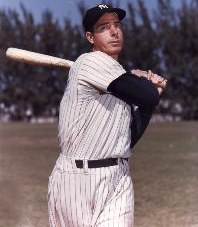|
The answer is yes, but only because hitting in 56 consecutive games is so much less
likely than hitting in 30, or even 44. As you can see on the
previous page, DiMaggio was about 300 times more
likely to hit in 30 consecutive games or more games than to hit in 56. Therefore, although DiMaggio
had a much better season than Kenny Landreaux, DiMaggio's 56 game streak was
still less likely than Landreaux's 31.
While no streak was as unlikely
as the famous 56, some others came close, including Rose's second-best 44.
The complete results are shown below for all the 30+ game streaks in the
20th and 21st centuries.
|
 |
|
|
Chances per million |
|
Player, Streak length |
|
133 |
|
DiMaggio 56 |
|
239 |
|
Rose 44 |
|
590 |
|
Landreaux 31 |
|
874 |
|
Santiago 34 |
|
1,108 |
|
Chase 33 |
|
3,092 |
|
Davis 30 |
|
3,307 |
|
Castillo 35 |
|
4,305 |
|
Molitor 39 |
|
4,436 |
|
DiMaggio (Dom) 34 |
|
4,665 |
|
Walton 30 |
|
4,727 |
|
Davis 31 |
|
4,939 |
|
Alomar 30 |
|
6,323 |
|
Guerrero 31 |
|
8,317 |
|
McQuinn 34 |
|
9,553 |
|
Goslin 30 |
|
12,907 |
|
LeFlore 30 |
|
13,859 |
|
Carty 31 |
|
18,235 |
|
Holmes 37 |
|
21,811 |
|
Musial 30 |
|
30,567 |
|
Gonzalez 30 |
|
32,646 |
|
Garciaparra 30 |
|
35,773 |
|
Pujols 30 |
|
37,574 |
|
Manush 33 |
|
40,322 |
|
Rice 31 |
|
40,472 |
|
Cobb 35 |
|
46,950 |
|
Sisler 34 |
|
49,681 |
|
Lajoie 31 |
|
79,948 |
|
Speaker 30 |
|
80,611 |
|
Brett 30 |
|
95,327 |
|
Sisler 41 |
|
95,740 |
|
Cobb 40 |
|
153,973 |
|
Hornsby 33 |
Notes:
- Pete Rose hit in 44 consecutive games in a season in which he succeeded in
only 27% of his plate appearances. Earlier in his career, however, Rose
had been an excellent type of player to achieve hit streaks. The 44 streak
would not have been such a surprise in 1973, when Rose succeeded in 31% of
his plate appearances, and came to the plate 4.66 times per game. This was
actually better than DiMaggio's 1941 stats, (31%, 4.44). Rose's 1973
season was two and a half times more likely to produce a long streak than
DiMaggio's 1941, but in 1978, the season when Rose actually pulled off the 44
game streak, it was a fluke.
- Landreaux? Go figure! Ken Landreaux succeeded in only 26% of his plate
appearances, and had only 4.05 plate appearances per game. He had a .281
batting average and barely exceeded one hit per game (136 hits in 129
games). That was, by far, the worst "hit streak season" among all of the
seasons which included a 30 game hit streak. Landreaux had zero chances
per million to hit in 56, but for all that he was still more likely to hit
in 31 straight than DiMaggio was to hit in 56 straight.
- The best "hit streak season" on the list was George Sisler's 1922. The
odds against him achieving a 30 game streak that year were only about 3-2.
The odds against his actual 41 game streak were about 9-1. The odds against him hitting in 56 straight were "only" about 75-1. Ty
Cobb's 1911 season was not far behind. Sisler had 246 hits in 142 games in
1922, and Cobb had 248 hits in 146 games in 1911.
- Just for the record, and to show how great DiMaggio was in the 1936-41
period, DiMaggio had three other seasons in which he was more likely to
produce a long streak than he was in 1941.
- The most completely predictable streak on the list was Hornsby's 33 in 1922. The odds against it
were only about 6-1. Hornsby had a great year that year, with 250 hits in
154 games, but there were three seasons worth mentioning that were more
likely to produce 30 game hitting streaks, but did not.
- Lefty O'Doul, 1929: 254 hits in 154 games. He was 40 times more
likely than DiMaggio to hit in 56 straight.
- Bill Terry, 1930: 254 hits in 154 games.
- Al Simmons 1925: 253 hits in 153 games.
- (Honorable mention: Chuck Klein, 1930: 250 hits in 156 games. Ichiro
Suzuki, 2001: 242 hits in 157 games. More on Ichiro in a minute.)
continue |
